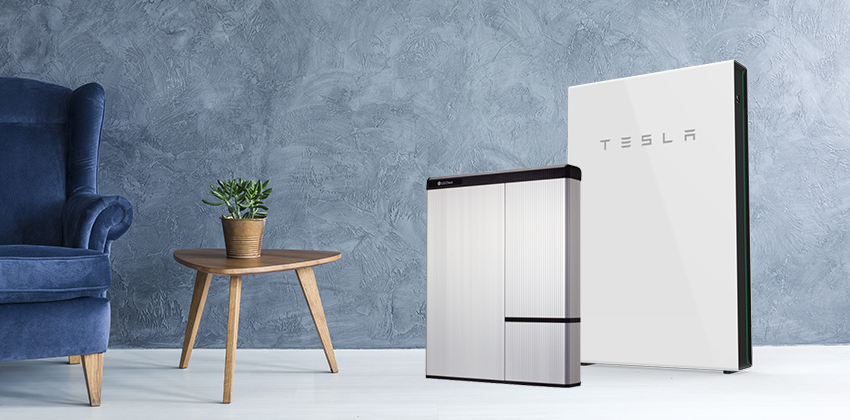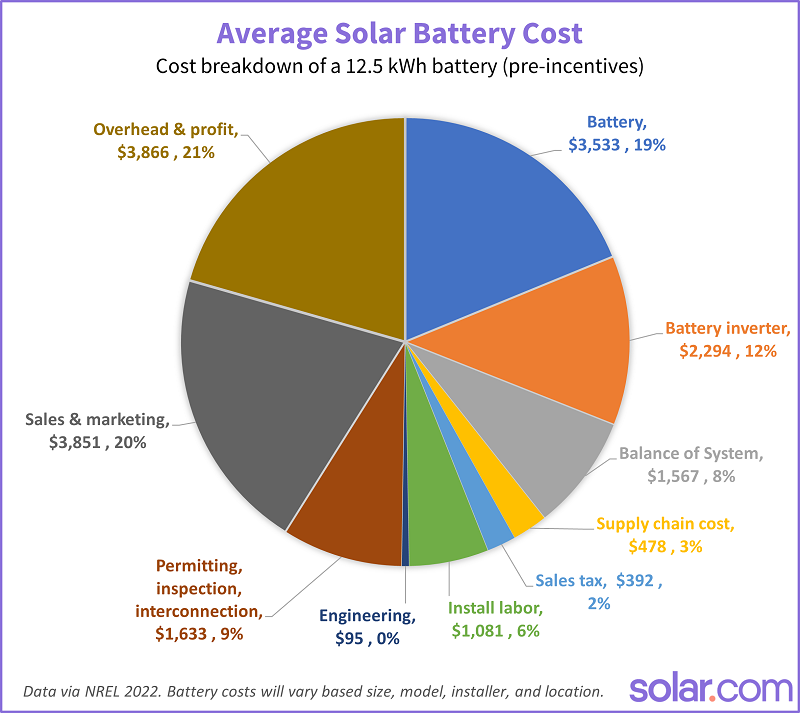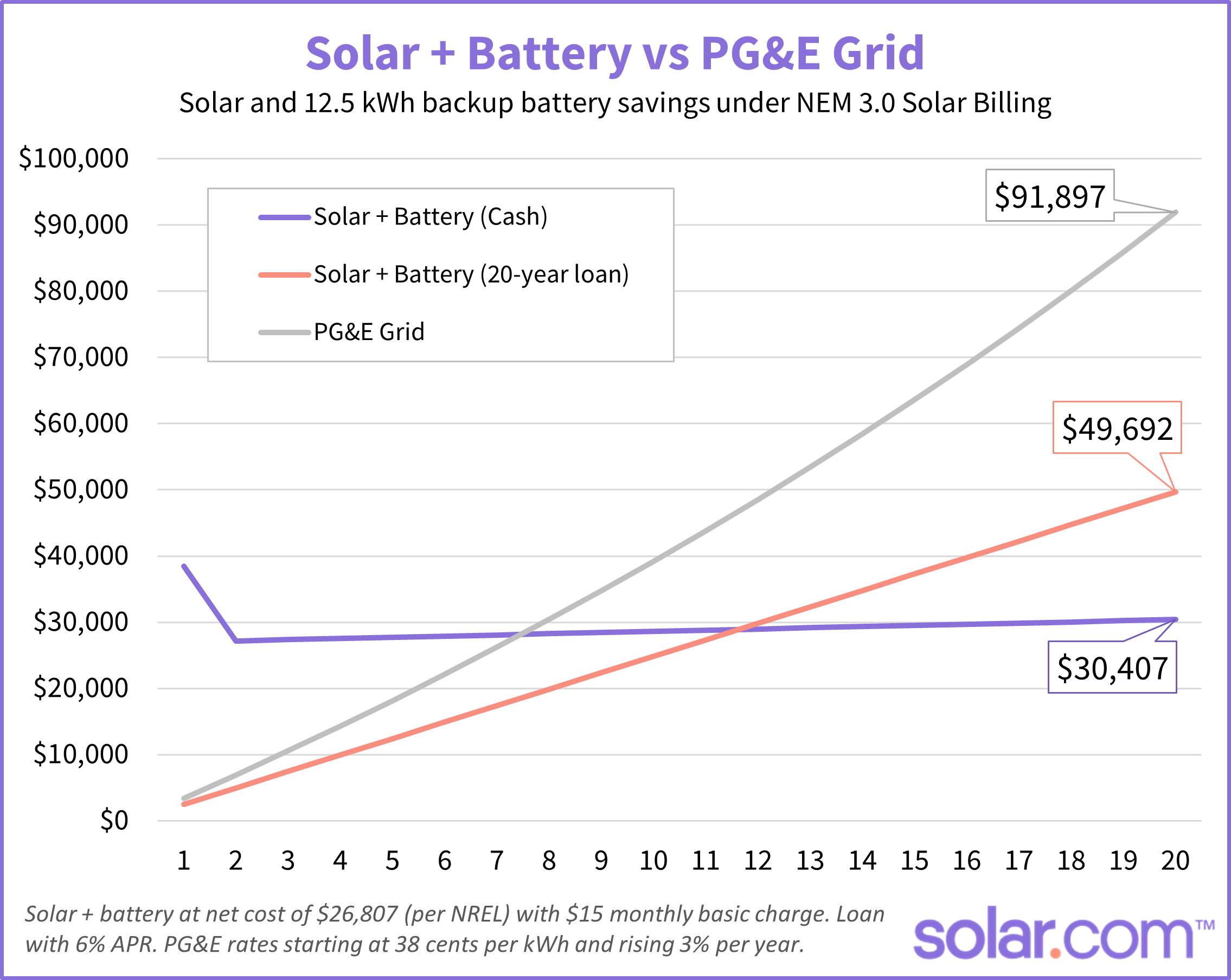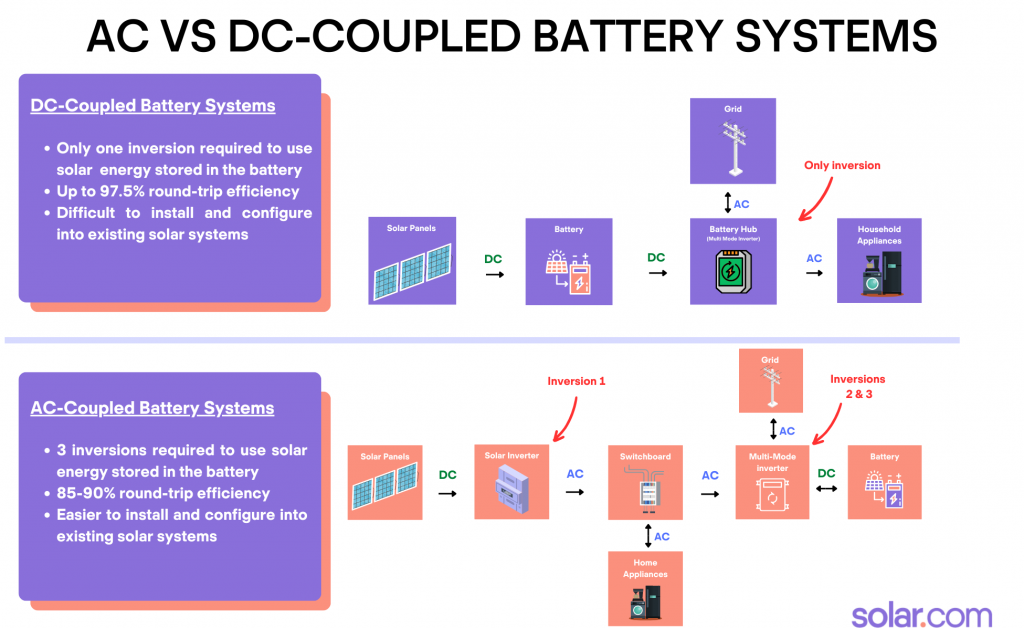See how much solar panels cost in your area

Please enter a valid zip code.
Zero Upfront Cost
Best Price Guaranteed
![]()
![]()
Solar Learning Center > Solar Battery > Solar Battery Prices: Is It Worth Buying a Battery in 2024?
Solar Battery Prices: Is It Worth Buying a Battery in 2024?

As grid outages increase nationwide, the idea of clean, quiet, and instantaneous battery backup power is growing in popularity among American homeowners.
But there’s one major hurdle standing in the way of widespread adoption: Solar battery prices.
Despite a 30% tax credit and fast-falling prices, the price of lithium-ion solar batteries still gives many homeowners sticker shock, despite the clear long-term benefits of cost savings and peace of mind.
In this article, we’ll explore the ins and outs of home battery pricing and six factors that influence the cost of a battery project.
- The average cost of a solar battery in 2024
- Popular battery prices
- Why are solar batteries so expensive?
- Six factors that influence battery costs
- Is solar battery worth the cost?
- Frequently asked questions
Let’s dive right in with the big question: How much do solar batteries cost in 2024?
What is the average cost of a solar battery in 2024?
The average cost of a fully installed standalone 12.5 kWh solar battery is $18,791 (or $13,154 after claiming the 30% tax credit), according to the latest data from the National Renewable Energy Laboratory (NREL).
However, that cost drops to around $15,000 ($10,500 with the tax credit) when the battery is installed at the same time as a solar system since much of the labor, configuration, and permitting costs overlap.
It’s worth noting that the NREL’s latest data is from early 2022 when lithium prices were climbing to a record high and around twice as high as they are today. Lithium-ion battery prices decreased in 2023 due to falling lithium prices, and are expected to continue falling (more on that later).
Compare live battery pricing from our vetted network of installers.
Solar battery cost per kWh
| Project size/type | Gross cost | Net cost (after 30% tax credit) | Battery cost per kWh (after 30% tax credit) |
| 12.5 kWh battery-only | $18,791 | $13,154 | $1,052 per kWh |
| 12.5 kWh battery installed with solar | $14,990 | $10,493 | $839 per kWh |
Data via NREL 2022
That brings the net cost of a fully installed 12.5 kWh solar battery to $840 and $1,050 per kWh, depending on whether it’s installed with solar or not.
If we apply this cost per kWh to various-sized solar battery projects, we find that fully-installed solar batteries cost between $5,000 and $19,000, depending on the size and scope of the project.
| Battery size | Installed with solar ($840 per kWh) | Battery-only ($1,050 per kWh) |
| 6 kWh | $5,040 | $6,300 |
| 9 kWh | $7,560 | $9,450 |
| 12.5 kWh | $10,500 | $13,125 |
| 15 kWh | $12,600 | $15,750 |
| 18 kWh | $15,120 | $18,900 |
It’s important to note that battery prices vary based on the type of equipment, product availability, and location.
In fact, based on the NREL’s breakdown, the actual equipment (battery, inverter, and balance of system) costs around $7,400 — 39% of the total cost of a standalone project — while soft costs like supply chain costs, installation labor, taxes, permitting/inspection/interconnection (PII), customer acquisition, and overhead make up the other 61%.

So, theoretically, two identical Enphase IQ 10 batteries could cost the same coming off the assembly line, but the installed cost to the homeowners will vary based on the soft costs specific to their installer and area.
Average cost of popular solar batteries in 2024
While solar batteries come in many shapes, sizes, and chemistries, a handful have emerged as the best batteries of 2024 and the most sought-after by homeowners.
The chart below lists the average retail price, estimated project cost after claiming the 30% tax credit, and cost per kWh of popular solar batteries.
Keep in mind – these figures are averages and estimates. Solar battery prices vary based on several factors!
| Brand/Model/Size | Retail price of battery + inverter | Estimated net project cost (battery-only)* | Cost per kWh (after tax credit) |
| Generac PWRcell (9 kWh) | $12,435 | $12,090 | $1,343 |
| LG Chem RESU10H (9.6 kWh) | $8,750 | $8,507 | $886 |
| Enphase IQ 10T (10.08 kWh) | $8,100 | $7,875 | $781 |
| Tesla Powerwall 2 (13.5 kWh) | $10,000 | $9,722 | $720 |
| Franklin Home Power (13.6 kWh) | $14,500 | $14,097 | $1,037 |
| LG ESS Home 8 (14.4 kWh) | $10,069 | $9,789 | $680 |
*Estimate project cost after 30% tax credit with balance of system, sales tax, labor, engineering, and PII making up 28% of total project cost per the NREL.
One thing to note is that the cost per kWh of solar batteries decreases as the project size gets larger, which is also true of solar panel costs. So, it’s often more cost-effective to install enough battery storage at once to cover your current and future needs than to gradually add more capacity over time.
Why are solar batteries so expensive?
There are a handful of factors that influence the price of solar batteries, but perhaps the greatest reason they are expensive is simply because residential-scale batteries are a new technology, and new technologies tend to be expensive at first before rapidly falling in price as the market matures.
For example, a 60-inch 4K TV cost around $9,000 in 2012. Today, you can walk into Target and buy a 65-inch 4K TV for under $400.
Lithium-ion batteries are on a similar trajectory, with the cost per kWh of individual battery cells falling 97% from 1991 to 2018.

It’s also important to put the cost of solar batteries into perspective. Sure, $27,000 for a solar and battery system sounds like a lot of money – and it is – but it’s far less expensive than paying for grid electricity over time.
The cost of solar & battery versus grid electricity
Take the largest utility in the US – Pacific Gas & Electric (PG&E) – which serves over 5 million households in California and regularly makes headlines for its planned and unplanned grid outages.
PG&E customers currently pay 38 cents per kWh on average for electricity. If that price rises at a conservative rate of 3% per year, the average customer would pay nearly $92,000 for electricity over 20 years.

Suddenly, home solar and battery storage don’t seem so expensive… And that’s not to mention the time, money, and comfort saved by having backup power during grid outages.
Six factors that influence solar battery costs
Solar battery prices are on a similar trajectory as 4K TVs. However, there are far more factors that influence the cost of a battery project than there are for installing a TV.
Beyond the cost of the battery itself, pricing factors include:
- Specialized engineering and installation labor,
- Permitting and inspection from your local government
- Interconnection from your utility provider
- Marketing an entirely new product
That’s a lot of different hands touching a single project! Some of these pricing factors can’t be controlled, but here are six things you can control when it comes to the cost of a battery.
Solar Battery Price Factor 1: Your battery capacity
The biggest factor that impacts the price of a solar battery is its capacity – the total amount of energy that it can store. Typically home batteries can store between 10 and 20kWh of electricity, and while bigger batteries come with a bigger price tag, they cost less per kWh of usable capacity.
Solar Battery Price Factor 2: DC vs AC
DC batteries like LG Chem tend to be less expensive than AC batteries since they’re less complex to configure (see chart below).
The kicker is that DC batteries are difficult to add to existing solar systems and, depending on the solar equipment, a DC battery may not be an option for all systems. On the other hand, AC batteries like the Tesla Powerwall can be configured into any new and existing solar system with relative ease.

Solar Battery Price Factor 3: Balance of System (BOS) Equipment
Installing a solar battery is not as simple as sticking a battery to the wall and running a wire to the main electrical panel. There are other important pieces of equipment that are critical to enabling home batteries to provide backup power.
The type, scope, and complexity of your balance of system equipment will influence the price of your overall project.
Backup Gateway
The backup gateway is a device that detects power outages and isolates the home from the electric grid. In that respect, it’s similar to a transfer switch for a generator. This is a critical component for allowing the solar battery to provide backup power without back-feeding power to the grid.

Image courtesy: Tesla
Critical Loads Panel
Most solar batteries have enough power to back up circuits up to 30amps. Therefore, the majority of battery systems do not back up the entire home, but rather just the circuits that are most important to the homeowner.
Therefore, installing a solar battery usually requires the installation of a sub-panel, often referred to as a “critical loads panel”, that houses the important circuits that will be backed up in an outage.
When the outage occurs, the backup gateway isolates the home from the grid and switches the battery to feed the critical loads panel, rather than the whole main electrical panel. This switchover only takes a fraction of a second – homeowners won’t even see their lights flicker!
Related reading: How Long Can Solar Battery Power a House During an Outage?

Whole-home backups are possible with batteries, although doing so will require multiple batteries, as sufficient battery power is required for even the highest-amperage, most energy-intensive applications in the home. As a result, the majority of homeowners opt for a critical loads backup to save the cost of multiple batteries.
Solar Battery Price Factor 4: Battery installers
After spending thousands of dollars on a solar battery, it’s best to make sure that the battery is installed properly, fully permitted, and functioning as intended for its full lifetime.
It’s therefore essential to install the battery using a vetted and experienced company that has experience with these systems. Going with a pro might cost a bit more upfront, but it’s totally worth it to avoid time and money to fix mistakes later on.
If it’s worth doing, it’s worth doing right!
Solar Battery Price Factor 5: Incentives
Incentives also have a significant impact on the cost of a solar battery system.
The most widely available incentive is the 30% federal tax credit. This is the same credit that applies to solar systems as well. However, as of 2023, home battery does not have to be connected to solar to qualify for the tax credit.
A couple of local battery incentives include:
Solar Battery Price Factor 6: Financing
Just like a house or car, home batteries can be financed to spread the upfront cost over a long period of time. If you buy solar and battery together, you can finance them together in the same loan. There are also financing options available for buying a battery on its own.
The upside to financing is that you can access the benefits of solar and/or battery with no money down, as long as you qualify for the loan. The downside is interest payments on the loan accrue over time to increase the overall cost of the system.
For example, using the example from earlier, financing a 7.9 kW solar system and 12.5 kWh battery with a 20-year loan (with zero money down) would cost nearly $47,000 while paying cash would cost around $30,000.

It’s worth noting that most solar and battery loans allow you to pay off the loan early and you can also make a down payment to lower the monthly principal and interest payments.
Is a Solar Battery Worth the Cost?
Whether solar battery storage is worth the cost in 2024 is totally up to you and your energy goals. If you experience frequent or long-lasting power outages, then having battery storage for backup power can be a game-changer in keeping you safe, productive, and comfortable (not to mention keeping your food from spoiling!).
Batteries are also used as a cost-savings tool in areas with unfavorable net metering policies, most notably California’s NEM 3.0 solar billing. In this case, the upfront cost of battery storage more than pays for itself by increasing monthly bill savings.
If battery storage isn’t in the cards right now, keep a close eye on battery prices going forward! The cost of solar batteries is forecasted to continue falling at a rapid pace as the industry matures and new technologies emerge.
Frequently asked questions
What is the average cost of a solar panel battery?
A fully-installed 12.5 kWh solar battery costs $13,000 on average, after claiming the 30% tax credit. That cost is closer to $10,500 if the battery is installed as part of a solar and battery project, as much of the soft costs (labor, permitting, inspection, interconnection, etc.) overlap.
How long will a 10kW battery last?
Most 10 kW solar batteries have warranties that guarantee 70% usable capacity after 10-12 years or a certain number of charge/discharge cycles. It’s worth noting that manufacturer warranties are typically quite conservative and the solar and battery equipment currently in deployment is far outperforming their warranties.
We simply won’t know exactly how long today’s batteries will last until they reach their useful end-of-life decades from now.
Is it worth adding a battery with solar panels?
Adding battery storage to a solar system is particularly worthwhile for homeowners who:
- Experience frequent and/or long-lasting grid outages
- Have critical systems (medical devices, water pumps, etc.) that run on electricity
- Want to store and use their own clean solar production, rather than pulling dirty electricity from the grid
- Have time-of-use rates and/or unfavorable net metering compensation
- Desire energy independence
- Want to contribute to a more resilient power grid and/or be ready to participate in Virtual Power Plant (VPP) arrangements
There are many reasons to add battery storage to a solar system – whether it’s worth it or not is up to you!
Related Articles
The 8 Best Solar Batteries of 2024 (and How to Choose the...
From backup power to bill savings, home energy storage can deliver various benefits for homeowners with and without solar systems. And while new battery brands...
What is SCE's New Home Energy Storage Pilot Incentive?
Southern California Edison — the state’s second-largest utility provider — is testing a new incentive program that aims to pre-install batteries in 2,400 new homes...
Home Solar Battery vs Generators for Power Outages
As a California-based company, Solar.com is painfully aware of the devastating effect that grid blackouts and power outages can have on homeowners. Just in late...
See how much solar panels cost in your area.

Please enter a valid zip code.

Please enter a valid zip code.
Zero Upfront Cost. Best Price Guaranteed.





